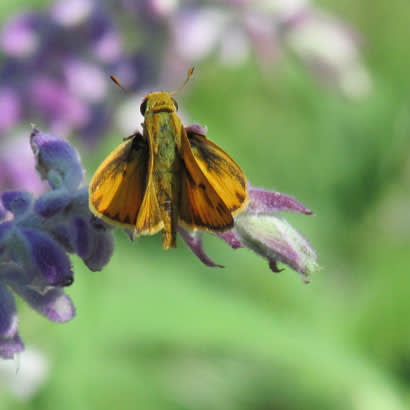
Pictured: Fiery Skipper (Hylephila phyleus). Photo by Ryan Stevens.
The City of Peoria, Arizona conducted its first BioBlitz in September 2020 when it took part in the NRPA Parks for Pollinators BioBlitz program. The objective, pre-pandemic, was to get more people out to our parks and trails. Additionally, we felt efforts to have the community take measures to reduce their dependency on pesticides were failing because people did not have a connection with our pollinators and their role in keeping our ecosystem alive. A BioBlitz would meet both these objectives. When it was announced that the BioBlitz would go virtual, it added momentum to the project. The BioBlitz became a vehicle to connect people to nature in their backyards and it offered a connection to a larger community, helping them feel less isolated.
Following the success of the September campaign, we launched a second BioBlitz this spring, the “Birds of Peoria BioBlitz.” Our community was very interested, and we shared both BioBlitz campaign results through our website, social media, internal employee forums and virtual classes. Our local news outlet, Channel 3, also featured the project on the Good Morning Arizona show.
Throughout the program, we had great support from NRPA, specifically Michele White, program manager. Michele helped in the setup of our iNaturalist project boundaries and was there to answer any questions. The materials Michele provided helped define the scope of the project and the media files were a source of inspiration for our communications team.
Since the BioBlitz was new to our community, we explained how to use the iNaturalist app to upload photos and how to participate safely during COVID-19 restrictions, since we did not host any in-person events. To make it easier for residents of all ages and abilities to participate, we offered to upload their photos for them, if needed. This was particularly helpful for community members that might not have access to a smartphone or technology, like some of our older adults. To encourage participants, we explained how the data would be used by scientists and our parks teams to help improve their knowledge about the diversity of pollinators, birds and the plants that support them.
The rich colors of the insects that live in the plants around us amazed us all! The Red Yellow Bee Assassin, the Giant Red Velvet mite and the Green Lynx spider were examples that took our breath away. Our bird BioBlitz is eliciting a similar response, as we witnessed spring migration. We generate a weekly report and it has become an educational opportunity for our parks crews. Because of this project and the conversations that it generated with parks and trail crews, I did an inventory of which plants support pollinators and what they look like on our trails during their early stages of development versus invasive plants that could be removed.
Because of the BioBlitz, we have been successful in establishing a dedicated pollinator garden, planted by Scouts and community volunteers at Heritage Court. We also received support from our trail maintenance crew to plant bird and butterfly-friendly plants at our Skunk Creek trailhead. Since this project, they have gone out of their way to ask questions before removing plant material. They have also invested in a sign to post by a dead tree to indicate to the public that they are saving it as a bird habitat. We collaborated with the Sonoran Audubon, the Desert Botanical Garden and Native Seed/Search in Tucson to populate these spaces with appropriate plants. These partners were great resources to help ensure the appropriate resilient native plants were incorporated and sourced. The success and exposure we experienced with the BioBlitz program made both these native planting projects possible, which will help build the resiliency and biodiversity of our parks and educate others on the importance of native habitat. We look forward to participating in the Parks for Pollinators BioBlitz program again!
Join us to raise awareness of pollinators nationwide by hosting a Parks for Pollinators BioBlitz in your community this September and you could win one of three $1,000 prizes or one of three Scotts Miracle-Gro prize packs to help with your pollinator habitats or programs!
Della Killeen is a Park Ranger for the City of Peoria Parks and Recreation Department in Arizona.
Note: The Parks for Pollinators campaign, hosted through a partnership between the National Recreation and Park Association (NRPA) and The ScottsMiracle-Gro Foundation, aims to raise public awareness of the pollinator crisis and encourage local action through public parks and recreation. NRPA and The ScottsMiracle-Gro Foundation believe parks play a key role in protecting and preserving pollinators and their habitats. Together, as part of ScottsMiracle-Gro’s GroMoreGood initiative, they are working to educate more children, families and communities about the importance of pollinators and what people can do to help.

